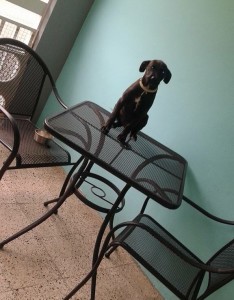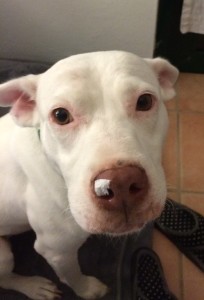Why the Where Matters: Marking & Reinforcing Behavior
When working with your dog and reinforcing behavior, the saying goes that we “mark” for behavior and “reinforce” for position. At the start this is often a new concept for clients.
An example of the usefulness of this behavior can be demonstrated as follows. The pup in the photo has jumped up on to the table to (reportedly) eat the cat food. Often we might see folks attempting to scold or physically remove the dog.
But, what does that teach the pup?
Instead, I suggest finding some behavior that we like (eye contact, orienting to name, collar grab) and then marking that behavior right where the dog is, but (key point here!) — tossing the reinforcer on to the floor!
You may need to repeat this process a few times. You also want to be sure that you are working with high value reinforcers, as you are competing with the “score” of finding the cat food on the table. However, eventually, that ever-growing pile of goodies (reinforcers) on the floor will become so tempting that the dog will jump down.
This is the point to mark again (yes! the dog now has four paws on the floor where you want them!) and reinforce. I suggest repeating this marking/reinforcing (click/treat if you like) over and over in quick succession several times in a row to strongly communicate that good things really DO happen on the floor and that the floor IS the spot to be!


